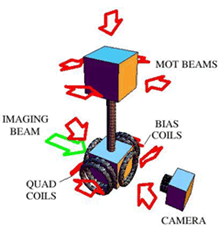 | ||||
 |
 |
| ||
 | ||||
Our lab and experimentsMost recent experiments
Our Apparatus A grating-stabilized diode laser and MOPA system operating at 300 mW was used for a double MOT configuration, with 60 % of the power transmitted by optical fibres to the cooling setup. A grating-stabilized diode laser and MOPA system operating at 300 mW was used for a double MOT configuration, with 60 % of the power transmitted by optical fibres to the cooling setup.87Rb atoms were collected in about 1 minute in a double MOT vertical configuration. A pressure gradient between the upper and lower MOT was realized by inserting a graphite narrowing. The atoms are transferred between MOTs using a push-beam from the top part of the apparatus; The quadrupole field is 18 G/cm. Following the loading stage, the atoms were compressed and cooled in an optical molasses phase. Then the rotating field was turned on and the atoms were optically pumped into the |F, mF> = |2, 2> level by a series of resonant circularly polarized pulses, synchronized with the rotation of the field. Finally, 5 x 107 atoms were loaded into the magnetic trap. A triaxial TOP trap with frequency in the ratio 1 : 21/2 : 2 was used for the first time to confine Rb atoms. A 10 KHz field rotates in the horizontal plane containing also the symmetry axis of the quadrupole field. The mean oscillation frequency of the trap at the time of loading was 12.7 Hz. An initial evaporative cooling was realized by narrowing the circle-of-death, i.e. increasing the quadrupole field and ramping down the rotating field amplitude, with a final trap mean frequency of 335 Hz. The condensation border line was reached by applying an RF field, whose frequency was scanned down, starting from the resonance with the spatial position of the circle-of-death, to lower values. Through the sequence of circle-of-death and RF evaporation the atoms were cooled down to T ~ 300 nK in a total of 35 s. An absorption image was taken 20 ms after adiabatically relaxing the trap to a mean frequency of 75 Hz, and a subsequent sudden switch-off of the trap. The expanded atom distribution showed a sharp peak along with a thermal background. Through a deeper RF cut, a pure condensate was produced. The characteristic signature of an anisotropic condensate peak superimposed on an isotropic thermal cloud background is missing in the case of our nearly spherical condensate distribution produced by the TOP trap. For further reading, please see J.H. Müller, D. Ciampini, O. Morsch, G. Smirne, M. Fazzi, P. Verlkerk, F. Fuso, and E. Arimondo, "Bose-Einstein condensation of rubidium atoms in a triaxial TOP trap", J. Phys. B: At. Mol. Opt. Phys 33, 4095 (2000). |
||||
|
For comments contact the web master: usala@df.unipi.it |
||||

